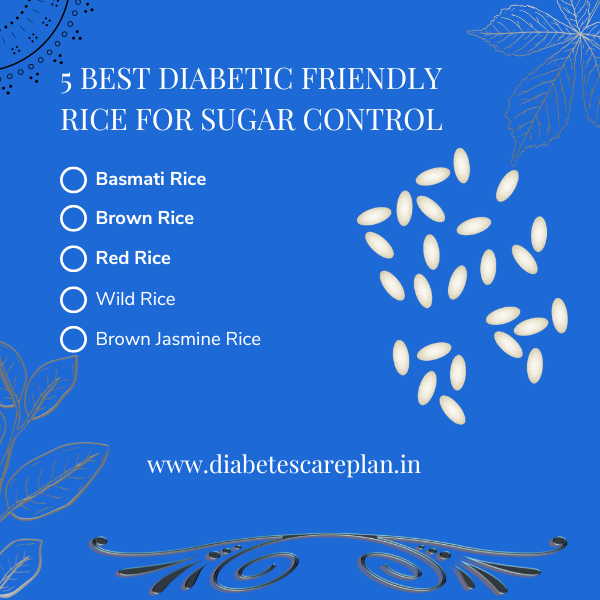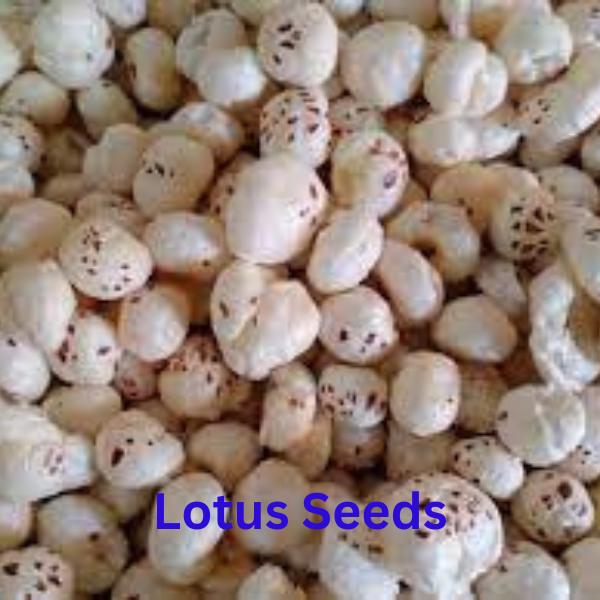Choosing the best Diabetic Friendly rice is very important for blood sugar management and individuals with diabetes.
With numerous varieties available, it is essential to select those that offer low to medium glycemic indexes, high fiber content, and rich nutritional profiles.
In this guide, we will explore five of the best diabetic-friendly rice options: Basmati rice, Brown rice, Red rice, Wild rice, and Brown Jasmine rice. Each of these varieties boasts unique properties that help in maintaining stable blood glucose levels, improving insulin sensitivity, and providing essential nutrients for overall health.
Now, we will discover how these types of rice can be incorporated into a balanced diet to support diabetes management effectively.
Here Are The Following 5 Best Diabetic Friendly Rice:
Table of Contents
1. Basmati Rice
Basmati rice is diabetic friendly rice and can be a better option for people with diabetes compared to other types of rice due to its unique properties. Here’s a detailed explanation on how Basmati rice may help in managing blood sugar levels, along with its properties:
Properties of Basmati Rice
1. Low to Medium Glycemic Index (GI):
A food’s ability to quickly boost blood glucose levels is measured by its Glycemic Index (GI). Lower GI foods are better in controlling blood sugar levels.
A basmati rice’s GI falls between 50 to 58, meaning it’s categorized as low to medium. This indicates that in comparison to foods with a high GI, it releases sugar into the bloodstream more slowly.
1. Complex Carbohydrates
Complex carbohydrates found in basmati rice cause the body to break down the grain more slowly, allowing glucose to enter the bloodstream more steadily. This aids in keeping blood sugar surges at bay.
2. Fiber Content:
Dietary fiber is abundant in basmati rice, particularly the brown kind. Carbohydrate digestion and absorption are slowed down by fiber, which can improve blood sugar regulation.
3. Aromatic and Flavored:
Without the inclusion of additional high-calorie ingredients, the distinct flavor and aroma of basmati rice can improve the palatability of diabetic-friendly dishes.
How Basmati Rice Can Help in Reducing Blood Sugar Levels
1. Slower Digestion and Absorption:
Basmati rice has a higher fiber content and a lower GI, which cause it to digest and absorb more slowly. This more gradual procedure aids in improving blood sugar regulation by preventing abrupt rises in blood glucose levels.
2. Improved Satiety:
Because basmati rice has fiber, it may help reduce overall food intake and avoid overeating by promoting a feeling of fullness. This can reduce blood sugar levels indirectly by preventing overindulgence in calories.
3. Nutrient Density:
In addition to being high in carbs, basmati rice is also a good source of iron, thiamine, and niacin. These nutrients can promote metabolic processes that contribute to stable blood sugar levels, which is crucial for overall health.
4. Lower Insulin Response:
Low- to medium-GI foods, such as basmati rice, cause a decreased insulin response. For those who have diabetes, this is advantageous since it lowers insulin resistance and enhances blood sugar control in general.
Practical Tips for Including Basmati Rice in a Diabetic Diet
1. Portion Control:
Though Basmati rice has a lower GI, it’s still important to watch portion sizes. Blood sugar levels can still rise even after heavy eating. It is normally advised to serve 1/4 to 1/2 cup of cooked Basmati rice each person.
2. Combine with Vegetables and Protein:
To further slow down the absorption of carbohydrates and help balance the meal, try serving Basmati rice with lean proteins and non-starchy veggies.
3. Choose Brown Basmati Rice:
Whenever possible, choose brown Basmati rice instead of white Basmati rice. Because brown basmati rice keeps more of its nutrients and fiber, it has even more advantages for blood sugar regulation.
4. Cook Properly:
Basmati rice’s GI might rise if it is overcooked. It keeps its low GI qualities better when cooked to a firm, al dente texture.
Final Word About Basmati Rice
People with diabetes may find that basmati rice is Diabetic Friendly rice, with its increased fiber content and lower glycemic index, is a good source of carbohydrates. It lowers blood sugar spikes and releases energy gradually, both of which are advantageous for controlling blood sugar levels. To optimize its advantages, it’s crucial to exercise portion control and pair it with other healthful foods.
2. Brown rice
Brown rice is another excellent option for individuals with diabetes. Here’s a detailed explanation on how brown rice may help in managing blood sugar levels, along with its properties:
Properties of Brown Rice
1. Low to Medium Glycemic Index (GI):
The GI of brown rice is between 50 and 55, meaning it is categorized as low to medium. In comparison to foods high in glycemic index, it results in a slower and less dramatic rise in blood glucose levels.
2. High Fiber Content:
Because brown rice keeps its exterior bran and germ, it has more nutritional fiber than white rice. Fiber is essential for controlling blood sugar levels because it reduces the rate at which carbs are absorbed and digested.
3. Rich in Essential Nutrients:
Essential minerals such as magnesium, phosphorus, selenium, manganese, and B vitamins can be found in good amounts in brown rice. These nutrients are essential for metabolic functions, such as controlling blood sugar, and general health.
4. Complex Carbohydrates:
Brown rice, like Basmati rice, has complex carbs that release glucose into the bloodstream more gradually due to their slower rate of breakdown.
5. Antioxidants
Antioxidants found in brown rice, such as phenolic compounds, have been related to improved blood sugar regulation by reducing oxidative stress and inflammation.
How Brown Rice Can Help in Reducing Blood Sugar Levels
1. Slower Digestion and Absorption:
Because brown rice has a high fiber content, it slows down the digestive process and releases glucose into the bloodstream more gradually. This reduces the chance of sharp increases in blood sugar.
2. Improved Insulin Sensitivity:
Brown rice contains magnesium, which is involved in glucose metabolism and insulin sensitivity. Those with diabetes can benefit from improved insulin function, which can be achieved with an adequate magnesium intake.
3. Enhanced Satiety:
Brown rice’s fiber helps you feel fuller for longer, which might help you limit how much you eat overall and avoid overindulging. This fullness may help with weight control, which is crucial for the management of diabetes.
4. Stabilized Blood Sugar Levels:
Brown rice helps to maintain more stable blood sugar levels throughout the day by lowering the likelihood of abrupt reductions or spikes because of its low GI and complex carbohydrate composition.
5. Nutrient Density:
Brown rice’s high nutrient content promotes both metabolic processes and general wellness. For instance, antioxidants can aid in reducing the chronic inflammation linked to diabetes, and B vitamins are essential for energy metabolism.
Practical Tips for Including Brown Rice in a Diabetic Diet
1. Portion Control:
Brown rice is the best diabetic friendly rice that offers several health benefits, but it’s important to watch portion sizes. To prevent consuming too many carbohydrates, a serving size of 1/4 to 1/2 cup of cooked brown rice is advised.
2. Combine with High-Fiber Vegetables and Lean Proteins:
Brown rice can be used with lean proteins and non-starchy vegetables to make a balanced meal that also aids with blood sugar regulation.
3. Variety and Balance:
To guarantee a balanced intake of minerals and fiber, include brown rice in a diversified diet together with other whole grains, veggies, and proteins.
4. Cooking Methods:
Brown rice’s GI may rise if it is overcooked. Its low GI qualities can be preserved by cooking it to a firm texture.
5. Gradual Transition:
If you decide to move from white rice to brown rice, do so gradually to give your digestive system and palate time to acclimate. Smoothing the transition at first can be achieved by combining the two.
Final Word About Brown Rice
With its high fiber content, rich nutrient profile, and low to medium glycemic index, brown rice is a diabetic friendly rice for those with diabetes who need to control their blood sugar levels.
It promotes better overall satiety, slower carbohydrate digestion and absorption, and increased insulin sensitivity—all of which lead to more stable blood glucose levels. The benefits of brown rice for blood sugar can be maximized by including it in a varied and balanced diet and exercising portion control.
3. Red Rice
Red rice is another valuable diabetic friendly rice option for individuals with diabetes. Here’s a detailed explanation of how red rice can help in managing blood sugar levels, along with its properties:
Properties of Red Rice
1. Low to Medium Glycemic Index (GI):
Red rice is classified as low to medium GI when its score falls between 55 and 65. This indicates that, in comparison to foods rich in GI, it causes a slower rise in blood glucose levels.
2. High Fiber Content:
Because the bran and germ layers are still there, red rice has a high nutritional fiber content. Fiber aids in blood sugar regulation by slowing down the breakdown and absorption of carbs.
3. Rich in Antioxidants:
The reddish hue of red rice is attributed to the presence of potent antioxidants called anthocyanins. By lowering oxidative stress and inflammation, antioxidants can enhance insulin sensitivity and overall blood sugar regulation.
4. Nutrient-Dense:
Essential elements including magnesium, iron, zinc, and B vitamins are all found in abundance in red rice. These nutrients are necessary for the metabolism of glucose among other metabolic activities.
5. Complex Carbohydrates:
Red rice has complex carbs, which release glucose into the bloodstream more gradually than simple carbohydrates because they break down more slowly.
How Red Rice Can Help in Reducing Blood Sugar Levels
1. Slower Digestion and Absorption:
Red rice’s high fiber content slows down the digestive process, causing the blood to release glucose into the bloodstream more gradually. This lessens the chance of sharp increases in blood sugar.
2. Improved Insulin Sensitivity:
Red rice contains magnesium, which helps to improve glucose metabolism and insulin sensitivity. Improved insulin sensitivity lowers blood sugar levels by enabling the body’s cells to use glucose more effectively.
3. Enhanced Satiety:
Red rice’s fiber helps you feel fuller for longer, which helps you manage how much you eat overall and avoid overindulging. Keeping oneself at a healthy weight is essential for diabetes management.
4. Antioxidant Benefits:
Red rice’s anthocyanins, which have anti-inflammatory and antioxidant qualities, aid in lowering inflammation and oxidative stress. Insulin sensitivity and general metabolic health may benefit from this.
5. Nutrient-Rich:
Practical Tips for Including Red Rice in a Diabetic Diet
1. Portion Control:
Red rice offers several health benefits, but it’s important to watch portion sizes. To minimize excessive consumption of carbohydrates, it is normally advised to provide 1/4 to 1/2 cup of cooked red rice.
2. Combine with High-Fiber Vegetables and Lean Proteins:
A balanced supper that lowers blood sugar levels can be made by serving red rice with lean proteins and non-starchy veggies.
3. Incorporate Variety:
A varied diet that includes vegetables, proteins, and other whole grains together with red rice guarantees a balanced intake of fiber and nutrients.
4. Proper Cooking Methods:
Red rice’s GI can be raised by overcooking it; avoid doing so. Its low GI characteristics can be preserved by cooking it till a solid texture.
5. Gradual Inclusion:
If you are switching from white rice to red rice, give your palate and digestive system some time to acclimate. Initially, combining red rice with other grains helps facilitate the shift.
Final Word About Red Rice
Red rice is a good option for controlling blood sugar levels in diabetics because of its high fiber content, powerful antioxidant qualities, low to medium glycemic index, and nutrient density. It helps improve insulin sensitivity, slow down the breakdown and absorption of carbohydrates, increase satiety, and has antioxidant properties that may improve metabolic health in general. Because of these inherent properties, Red Rice is considered as a diabetic friendly rice.
4. Wild Rice
Wild rice is another excellent option for individuals with diabetes. Here’s a detailed explanation of how wild rice can help in managing blood sugar levels, along with its properties:
Properties of Wild Rice
1. Low Glycemic Index (GI):
Wild rice has a low glycemic index, typically around 45 to 53. This means it causes a slower increase in blood glucose levels compared to high GI foods.
2. High Fiber Content:
Wild rice is rich in dietary fiber, which plays a crucial role in slowing down the digestion and absorption of carbohydrates, thereby helping in blood sugar management.
3. Nutrient-Dense:
Wild rice is packed with essential nutrients, including magnesium, phosphorus, zinc, iron, and B vitamins. These nutrients support various metabolic processes, including glucose metabolism.
4. Rich in Antioxidants:
Wild rice contains antioxidants such as phenolic acids and flavonoids, which help reduce oxidative stress and inflammation, improving insulin sensitivity and overall metabolic health.
5. Complex Carbohydrates:
Wild rice is composed of complex carbohydrates that are broken down more slowly by the body, providing a gradual release of glucose into the bloodstream.
How Wild Rice Can Help in Reducing Blood Sugar Levels
1. Slower Digestion and Absorption:
The high fiber content in wild rice slows down the digestion process, leading to a more gradual release of glucose into the bloodstream. This helps in preventing rapid spikes in blood sugar levels.
2. Improved Insulin Sensitivity:
Magnesium, found in wild rice, is essential for insulin sensitivity and glucose metabolism. Adequate magnesium intake helps improve the efficiency of insulin in the body, thereby managing blood sugar levels better.
3. Enhanced Satiety:
The fiber in wild rice promotes a feeling of fullness, which can help in controlling overall food intake and prevent overeating. Maintaining a healthy weight is crucial for managing diabetes.
4. Antioxidant Benefits:
The antioxidants present in wild rice help in reducing inflammation and oxidative stress, both of which can impair insulin function. By improving insulin sensitivity, wild rice helps in better blood sugar control.
5. Nutrient-Rich:
Wild rice is a diabetic friendly rice provides essential nutrients that support overall health and metabolic functions. For instance, B vitamins are crucial for energy metabolism, while iron and zinc support immune function and overall well-being.
Practical Tips for Including Wild Rice in a Diabetic Diet
1. Portion Control:
Even though wild rice has beneficial properties, portion control is essential. A serving size of 1/4 to 1/2 cup of cooked wild rice is generally recommended to avoid excessive carbohydrate intake.
2. Combine with High-Fiber Vegetables and Lean Proteins:
Pairing wild rice with non-starchy vegetables and lean proteins can create a balanced meal that helps in regulating blood sugar levels.
3. Incorporate Variety:
Including wild rice as part of a varied diet that features other whole grains, vegetables, and proteins ensures a balanced intake of nutrients and fiber.
4. Proper Cooking Methods:
Avoid overcooking wild rice, as it can increase its GI. Cooking it to a firm texture helps maintain its low GI properties.
5. Gradual Inclusion:
If transitioning from other types of rice to wild rice, do so gradually to allow your palate and digestive system to adjust. Mixing wild rice with other grains initially can help ease the transition.
Final Word About Wild Rice
With its high fiber content, rich antioxidant capabilities, low glycemic index, and nutritional value, wild rice is a good option for diabetics to control their blood sugar levels. In addition to improving insulin sensitivity, slowing down the breakdown and absorption of carbs, increasing satiety, and offering antioxidant advantages, it also improves overall metabolic health.
You may optimize wild rice’s benefits for blood sugar control by including it in a varied, balanced diet and controlling portion sizes.
5. Brown Jasmine Rice
Brown Jasmine rice is another nutritious option for individuals with diabetes. Here’s a detailed explanation on how Brown Jasmine rice can help in managing blood sugar levels, along with its properties:
Properties of Brown Jasmine Rice
1. Medium Glycemic Index (GI):
Brown Jasmine rice has a medium glycemic index, typically around 50 to 55. This means it causes a moderate increase in blood glucose levels compared to high GI foods.
2. High Fiber Content:
Because brown jasmine rice keeps its outer bran layer, it has more dietary fiber than white rice. In order to help control blood sugar, fiber is essential for slowing down the digestion and absorption of carbs.
3. Nutrient-Rich:
Brown Jasmine rice is packed with essential nutrients like magnesium, phosphorus, manganese, and B vitamins. These nutrients support various metabolic processes, including glucose metabolism.
4. Antioxidants:
Brown Jasmine rice contains antioxidants, which help in reducing inflammation and oxidative stress, improving insulin sensitivity and overall metabolic health.
5. Complex Carbohydrates:
The rice contains complex carbohydrates that are broken down more slowly, leading to a more gradual release of glucose into the bloodstream.
How Brown Jasmine Rice Can Help in Reducing Blood Sugar Levels
1. Slower Digestion and Absorption:
The high fiber content in Brown Jasmine rice slows down the digestion process, resulting in a more gradual release of glucose into the bloodstream. This helps in preventing rapid spikes in blood sugar levels.
2. Improved Insulin Sensitivity:
Magnesium, found in Brown Jasmine rice, plays a crucial role in improving insulin sensitivity and glucose metabolism. Adequate magnesium intake helps enhance the efficiency of insulin in the body, managing blood sugar levels more effectively.
3. Enhanced Satiety:
The fiber in Brown Jasmine rice promotes a feeling of fullness, which can help in controlling overall food intake and prevent overeating. Maintaining a healthy weight is important for managing diabetes.
4. Antioxidant Benefits:
The antioxidants present in Brown Jasmine rice help in reducing inflammation and oxidative stress. This can improve insulin sensitivity and contribute to better blood sugar control.
5. Nutrient-Dense:
Brown Jasmine rice provides essential nutrients that support overall health and metabolic functions. B vitamins, for instance, are crucial for energy metabolism, while manganese supports bone health and metabolic processes.
Practical Tips for Including Brown Jasmine Rice in a Diabetic Diet
1. Portion Control:
Even though Brown Jasmine rice has beneficial properties, portion control is essential. A serving size of 1/4 to 1/2 cup of cooked Brown Jasmine rice is generally recommended to avoid excessive carbohydrate intake.
2. Combine with High-Fiber Vegetables and Lean Proteins:
Mixing Brown Jasmine rice with non-starchy vegetables and lean proteins can create a balanced meal that helps in regulating blood sugar levels.
3. Incorporate Variety:
Including Brown Jasmine rice as part of a varied diet that features other whole grains, vegetables, and proteins ensures a balanced intake of nutrients and fiber.
4. Proper Cooking Methods:
Avoid overcooking Brown Jasmine rice, as it can increase its GI. Cooking it to a firm texture helps maintain its low to medium GI properties.
5. Gradual Inclusion:
If changing from white rice to Brown Jasmine rice, do so gradually to allow your palate and digestive system to adjust. Mixing Brown Jasmine rice with other grains initially can help accommodate the changes.
Final Word About Brown Jasmine Rice
Because of its high fiber content, powerful antioxidant capabilities, medium glycemic index, and nutrient density, brown jasmine rice is a good option for controlling blood sugar levels in diabetics.
In addition to improving insulin sensitivity, slowing down the breakdown and absorption of carbs, increasing satiety, and offering antioxidant advantages, it also improves overall metabolic health.
The benefits of brown jasmine rice for blood sugar regulation can be maximized by including it in a varied and balanced diet and exercising portion control.
Table of Summary for The Properties of 5 Rices
Here’s a table summarizing the diabetes-friendly properties of Basmati rice, Brown rice, Red rice, Wild rice, and Brown Jasmine rice:
| Property | Basmati Rice | Brown Rice | Red Rice | Wild Rice | Brown Jasmine Rice |
| Glycemic Index (GI) | Low to Medium (50-58) | Low to Medium (50-55) | Low to Medium (55-65) | Low (45-53) | Medium (50-55) |
| Fiber Content | Moderate | High | High | High | High |
| Nutrient Density | Good (thiamine, niacin, iron) | High (magnesium, phosphorus, selenium, manganese, B vitamins) | High (magnesium, iron, zinc, B vitamins) | High (magnesium, phosphorus, zinc, iron, B vitamins) | High (magnesium, phosphorus, manganese, B vitamins) |
| Antioxidants | Moderate | Moderate to High | High (anthocyanins) | High (phenolic acids, flavonoids) | Moderate |
| Complex Carbohydrates | Yes | Yes | Yes | Yes | Yes |
| Digestion and Absorption | Slower, helps prevent spikes | Slower, helps prevent spikes | Slower, helps prevent spikes | Slower, helps prevent spikes | Slower, helps prevent spikes |
| Improves Insulin Sensitivity | Moderate | High (due to magnesium) | Moderate to High (due to magnesium) | High (due to magnesium) | High (due to magnesium) |
| Satiety | Moderate | High | High | High | High |
Explanation of Table Entries
- Glycemic Index (GI): Measures how quickly a carbohydrate-containing food raises blood glucose levels. Lower GI values are better for managing blood sugar.
- Fiber Content: Higher fiber content helps in slowing down digestion and absorption of carbohydrates, aiding in blood sugar management.
- Nutrient Density: Richness in essential nutrients like magnesium, iron, zinc, and B vitamins, which support metabolic health.
- Antioxidants: Presence of antioxidants that reduce inflammation and oxidative stress, improving insulin sensitivity.
- Complex Carbohydrates: Slow-release carbohydrates that prevent rapid spikes in blood glucose levels.
- Digestion and Absorption: Slower digestion and absorption help in maintaining stable blood glucose levels.
- Improves Insulin Sensitivity: Nutrients that help improve the efficiency of insulin in the body, aiding in better blood sugar control.
- Satiety: High fiber content promotes a feeling of fullness, which helps in controlling food intake and managing weight.
This table should help you compare and understand the diabetes-friendly properties of these different types of rice.
Final Summary
In conclusion, choosing the appropriate variety of rice can be crucial to successfully treating diabetes. Basmati rice, Brown rice, Red rice, Wild rice, and Brown Jasmine rice all have special advantages that help with blood sugar regulation.
Because of their high fiber content, rich nutritional profiles, and low to medium glycemic indices, they are great options for people who want to keep their blood glucose levels constant. These rice varieties that are suitable for diabetics can be included in a balanced diet to support overall metabolic health by promoting satiety, enhancing insulin sensitivity, and providing vital nutrients.
Making educated decisions regarding the kind of rice one eats can greatly improve the way one manages their diet for diabetes.
Call To Action
Are these rices part of a diabetes management plan? Share your experiences and tips in the comments below!
Sign up for our newsletter for more healthy tips and delicious recipes. See the links below for additional resources and research on the benefits of pumpkin seeds for diabetes.
Click Here To Know More About Diabetes Recipes Category
Click Here To Know More About Herbal Remedies for Diabetes





